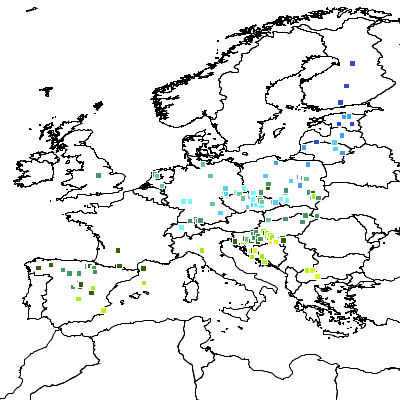There is a long list of new features, enhancements and bug fixes in this release:
Functionality Improvements
- Changed GeometryFactory.createGeometry() to make a deep copy of the argument Geometry, using the CoordinateSequenceFactory of the factory
- Added ability to specify a dimension in CoordinateArraySequence
- Changed Geometry.getEnvelopeInternal() to return a copy of the cached envelope, to prevent modification
- Added GeometryEditor.CoordinateSequenceOperation to allow easy editing of constituent CoordinateSequences
- Added GeometryFactory.createPolygon convenience methods which do not require holes to be specified
- Geometry overlay methods now return empty results as atomic types of appropriate dimension
- Added RectangleLineIntersector to provide efficient rectangle-line intersection testing
- Added getOrdinate and setOrdinate to Coordinate
- Quadtree is Serializable
- STRtree is Serializable
- Added max, average and wrap functions to MathUtil
- Improved WKTReader parse error reporting to report input line of error
- Improved
WKBReaderto repair structurally-invalid input - Made TopologyPreservingSimplifier thread-safe
- Added AbstractSTRtree.isEmpty() method
- Added QuadTree.isEmpty() method
- Added KdTree.isEmpty() method
- Added decimation and duplicate point removal to ShapeWriter.
- ScaledNoder now preserves Z values of input
- Added instance methods for all Triangle static methods
- Added CGAlgorithmsDD containing high-precision versions of some basic CG algorithms
- Added IntersectionMatrix.isTrue() method for testing IM pattern matches
- Added
getRawCoordinatesmethods toPackedCoordinateSequenceconcrete classes - Modified
Geometry.isSimple()to explicity check for simplicity for all types, and supportGeometryCollections - Improved
MCIndexSnapRounderto add nodes only where they are necessary - Added
CoordinateArrays.removeNull()method - Enhanced
GeometryEditorto handle null geometries returned from operation - Added
WKBHExFileReader - Added
Distance3Doperation
Performance Improvements
- Simplified & improved performance of RectangleIntersects by using new RectangleLineIntersector
- In RandomPointsInGridBuilder eliminated redundant ArrayList usage
- In PreparedPolygonIntersects and PreparedLineStringIntersects added check to avoid creating segment index if all test inputs are points
- In AbstractSTRtree switched to using indexed list access for better performance than using iterators
- In AbstractSTRtree freed inserted item array after index is built
- Improved performance of Polygonizer for cases with many potential holes
- Improved performance for some DD methods by making them final
- Added fast filter for CGAlgorithmsDD.orientationIndex, and switched to self-operations for DD determinant
- Changed
STRtree.createNode()to use a static class for nodes - Changed
QuadTree Nodeto use scalar x and y variables rather than aCoordinateto reduce memory allocation - Fixed
PreparedGeometryconcrete classes to be thread-safe. - Fixed
SortedPackedIntervalRTreeso that it is thread-safe.
Robustness Improvements
- Switched to using DD extended-precision arithmetic to compute orientation predicate
CGAlgorithms.distanceLineLine()improved to be more robust and performant- Fixed robustness issue causing Empty Stack failure in ConvexHull for some nearly collinear inputs
- CGAlgorithms.signedArea() uses a more accurate algorithm
Bug Fixes
- Fixed Geometry.equalsExact() to avoid NPE when comparing empty and non-empty Points
- Fixed CascadedPolygonUnion to discard non-polygonal components created during unioning, to avoid failures and provide more desirable behaviour
- Fixed CentralEndpointIntersector to initialize result correctly
- Fixed DelaunayTriangulationBuilder.extractUniqueCoordinates(Geometry) to avoid mutating the vertex order of the input Geometry
- Fixed ConformingDelaunayTriangulationBuilder to allow non-disjoint site and constraint vertex sets
- Fixed RandomPointsInGridBuilder point generation to use circle constraint correctly
- Fixed Linear Referencing API to handle MultiLineStrings consistently, by always using the lowest possible index value, and by trimming zero-length components from results
- Fixed bug in LocationIndexedLine and LengthIndexLine which was causing an assertion failure when the indexOfAfter() method was called with a constraint location which is at the end of the line
- Fixed bug in STRtree.query(Envelope, ItemVisitor) causing an NPE when tree is empty
- Fixed issue with creating zero-length edges during buffer topology building under fixed precision, by: adding filter to remove zero-length edges; using a better estimate of scale factor for reducing to fixed precision after initial failure.
- Fixed TopologyPreservingSimplifier to return a valid result for closed LineStrings with large distance tolerances
- Fixed TopologyPreservingSimplifier to return an empty result for an empty input
- Fixed DouglasPeuckerSimplifier to return an empty result for an empty input
- Fixed MinimumBoundingCircle to correctly compute circle for obtuse triangles.
- Fixd GeometryPrecisionReducer to use input GeometryFactory when polygon topology is fixed
- Fixed GeometryNoder bug that was failing to snap to end vertices of lines
- Fixed Geometry.getCentroid() and Geometry.getInteriorPoint() to return POINT EMPTY for empty inputs
- Fixed DelaunayTriangulationBuilder to correctly extract unique points
- Fixed KdTree to correctly handle inserting duplicate points into an empty tree
- Fixed LineSegment.projectionFactor() to handle zero-length lines (by returning Double.POSITIVE_INFINITY)
- Fixed LocationIndexedLine to handle locations on zero-length lines
- Fixed
LengthIndexedLineandLocationIndexedLineto handleindexOfAfter()correctly - Fixed
WKBReaderto handle successive geometrys with different endianness - Fixed
GeometricShapeFactoryto correctly handle setting the centre point - Fixed
GeometryFactory.createMultiPoint(CoordinateSequence)to handle sequences of dimension > 3
API Changes
- Changed visibility of TaggedLineStringSimplifier back to public due to user demand
Testing
- Added Performance Testing framework (PerformanceTestRunner and PerformanceTestCase)
- Added named predicate tests to all Relate test cases
JTS TestBuilder
Functionality Improvements
- Added segment index visualization styling
- Improved Geometry Inspector
- Added stream digitizing for Polygon and LineString tools
- Added output of Test Case XML with WKB
- Added Extract Component tool
- Added Delete Vertices Or Components tool
- Added Geometry Edit Panel pop-up menu, with operations
- Added Halton sequence functions
- Added sorting functions
- Added function for selection of first N components
- Added CGAlgorithms functions
- Added ability to paste and load multiple WKBHex geometries
Performance Improvements
- Using decimation substantially improves rendering time for large geometries.
Bug Fixes
- Fixed bug in saving XML test files























